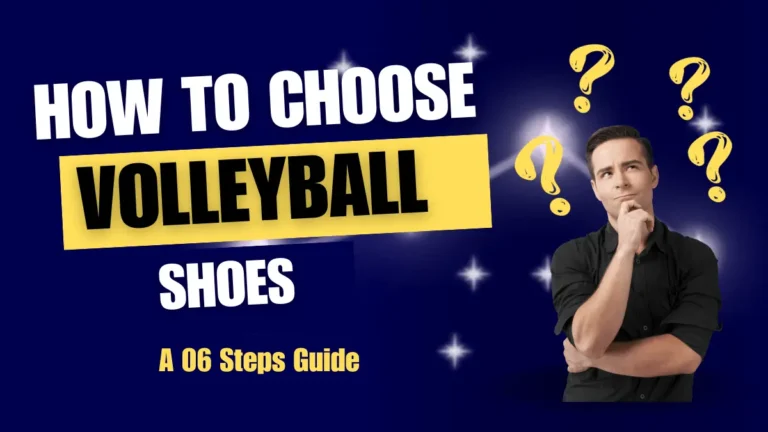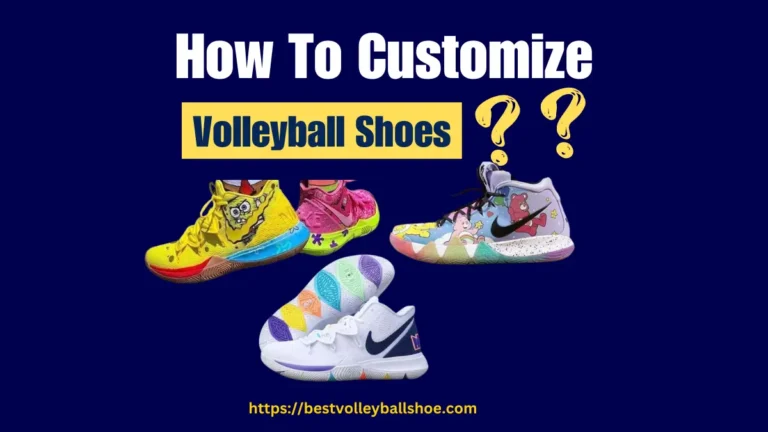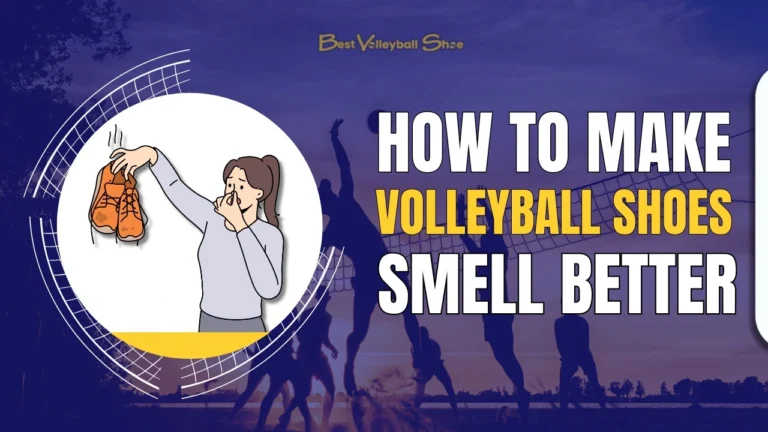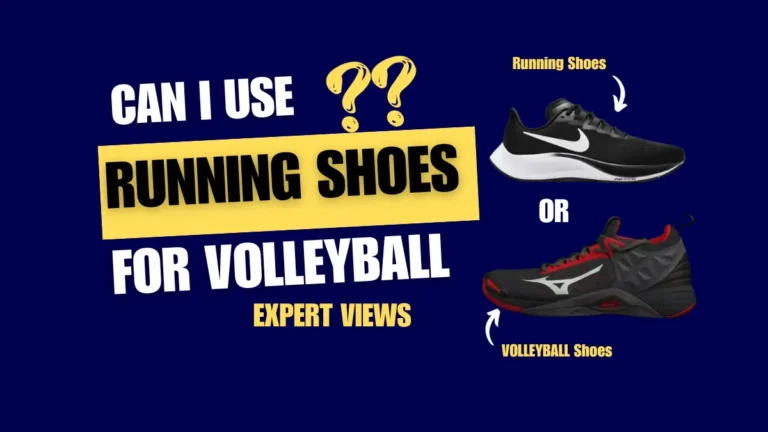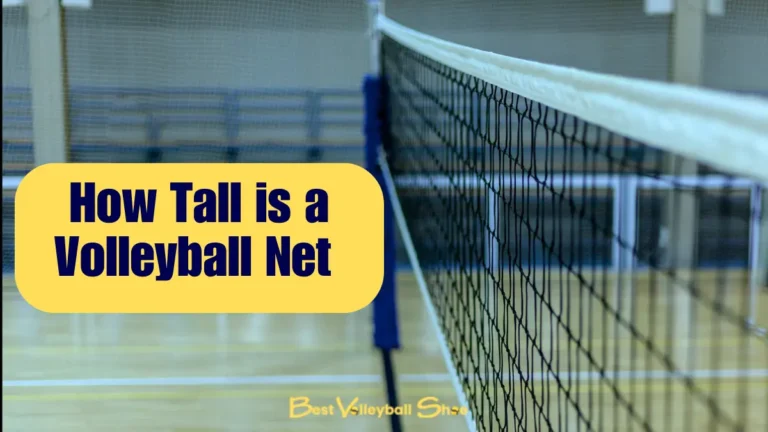Can You Use Tennis Shoes for Volleyball

If you are also among those who consider volleyball and tennis shoes the same, get ready for poor performance and injury.
As a former volleyball player with over 10 years of experience, I know that while tennis shoes and volleyball shoes may look similar at first glance, they are designed very differently to meet the demands of each sport.
Volleyball shoes have gum rubber soles for traction on hard courts, a lightweight design for agility, and support for lateral motions that tennis shoes lack. Their sport-specific build provides control and prevents slipping during quick starts and stops.
Whether you are a casual player, high school athlete, or professional, it is key to understand the differences between tennis shoes and volleyball shoes. Also, you need to know when to avoid using tennis shoes and when you might be able to get by with them. And what to look for when selecting volleyball shoes.
If you aren’t knowledgeable about all of this yet, no worries! you can make the smartest choice for your feet and your performance on the court.
Let’s break it down in detail of can you use tennis shoes for volleyball so
What are the Key Differences Between Tennis Shoes and Volleyball Shoes?
While tennis shoes and volleyball shoes may look similar at first glance, they are designed differently to meet the demands of each sport. Here are some of the key differences:
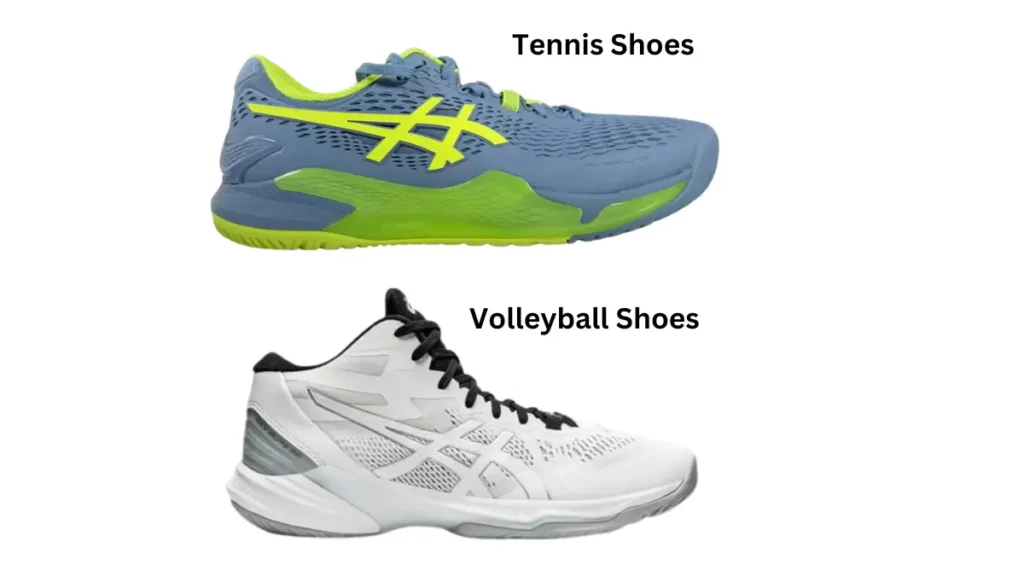
Traction
You will notice that tennis and volleyball shoes have traction patterns designed for their respective sports.
Tennis Shoes
Tennis shoes have aggressive soles that grip the court surface, allowing you to take off quickly and change direction on a dime. These traction patterns are optimized for quick starts and stops. The soles have patterns that stick, helping you take off fast and switch directions quickly.
Volleyball Shoes
While volleyball shoes have good traction, the patterns are not as aggressive since you don’t need to be quite as fast in volleyball. Their soles are designed for traction on gym floors. They allow players to move quickly in all directions and maintain balance for jumping.
Cushioning
Tennis Shoes
When you step into tennis shoes, get ready for some serious comfort. The cushioning, especially in the heel, is like a soft landing pad for your feet.
You’ll feel the difference as you sprint across the tennis court and make sudden stops. The extra padding absorbs the shocks, giving you a smoother and more comfortable ride. It’s like having a little mattress for your feet, making those quick movements a breeze.
Volleyball Shoes
Now, imagine sliding into volleyball shoes. The cushioning is there, but it’s not like that of tennis shoes instead its dense and more supportive and shock absorbent. Why? Because in volleyball, you’re spiking and doing intensive and extensive jumping in the match. The volleyball shoes are designed in a way to give maximum shock mitigation However, lateral stability is common in both shoes.
Weight
Tennis Shoes
When you wear tennis shoes, they’re super light! It’s like having feathers on your feet. You’ll feel quick and agile on the tennis court, smoothly gliding around. These shoes make sure your movements are easy and fast.
Volleyball Shoes
On the other hand, volleyball shoes are a bit heavier, but that’s a good thing. You’ll appreciate the extra weight when you jump and land hard in volleyball. It helps you stay stable, like having a solid base. So, in these shoes, you’ll feel supported and steady, making those powerful moves on the volleyball court.
Height
Tennis Shoes
Tennis shoes have short tops. This helps you move quickly and bend easily on the tennis court. Picture yourself dashing around, turning smoothly as you chase after the ball. These shorter tops make sure your movements are easy and fast.
Volleyball Shoes
The shoes are a bit different. They have higher tops. This is like having a little extra support around your ankles. It’s handy when you move sideways in volleyball. It also reduces the chance of hurting your ankle when you land after a jump. So, while playing volleyball, these shoes give you extra protection, letting you focus on the game without worrying about injuries.
Material
Tennis Shoes
When you wear tennis shoes, you’ll notice they’re made of breathable stuff like mesh and lightweight synthetics. In this way, your feet stay cool during long matches. It’s like your shoes let in a fresh breeze, keeping you going strong, even in the heat of the game.
Volleyball Shoes
While volleyball shoes are a bit tougher, they use leather and synthetic overlays, making them strong and durable. It’s like having a sturdy shield around your feet. This is super helpful when playing volleyball and making those powerful jumps and landings. Your feet get the support they need, ensuring you stay strong and safe during the intense moments on the court.
Key Reasons Volleyball Shoes Outperform Tennis Shoes
Tennis shoes may seem like they would work for volleyball. However, they lack key features volleyball players need to perform their best and prevent injury during competition. Let’s examine why proper volleyball shoes outperform tennis sneakers on the court.
Inadequate Grip on Hardwood Courts
Tennis shoes have hard soles meant for soft tennis courts. Volleyball courts are hardwood, so tennis shoes don’t grip the floor well. This lack of grip makes it hard to move quickly or change direction. Volleyball shoes are designed to grip hardwood better.
Lack of Shock Absorption in Tennis Shoes
Tennis shoes don’t provide enough shock absorption for the constant jumping in volleyball. All the impact from jumping can make your legs and joints ache if you wear tennis shoes. Volleyball shoes have more cushioning to absorb shock.
Different Needs for Different Positions
Volleyball players in different positions have different needs for their shoes. Backcourt players who don’t jump as much don’t need as thick of a sole. Frontcourt players who jump more often need more cushioning to absorb the impact of jumping.
Absence of Desired Jumping Experience
Good volleyball shoes should give you a springy, bouncy feel when jumping and landing. This helps you jump higher and land softly. Tennis shoes don’t provide the jumping experience that volleyball players want.
In summary, volleyball shoes are optimized for volleyball’s demands through their cushioning, shock absorption, springy feel, and floor grip. Tennis shoes aren’t designed for volleyball’s specific needs.
Can You Use Tennis Shoes for Volleyball?
While tennis shoes and volleyball shoes are designed differently, it is possible to use tennis shoes for volleyball if needed. Here are some things to consider:
- Casual, recreational play – Tennis shoes will generally be fine for recreational volleyball games with low intensity. The traction may not be ideal, but the cushioning can help reduce fatigue.
- High school practices – Tennis shoes could work for practicing basic skills like setting, passing, and serving where intense lateral motions are limited. Cushioning can help for long practices on hard floors.
- As a backup pair – When your primary volleyball shoes are unavailable, tennis shoes can get you through a practice or game in a pinch. They provide the ankle support needed for volleyball.
- For hitting drills – Tennis shoes provide stability for repetitive jumping drills like hitting lines or 3-man drills where each player stays within a zone.
- For outdoor volleyball – On grass or sand courts, tennis shoes work well since the traction of volleyball shoes is designed for indoor floors.
When Should You Avoid Using Tennis Shoes for Volleyball?
There are some situations where tennis shoes may not be suitable for volleyball:
- Matches or high-level competitive play – The lack of lateral stability and volleyball-specific traction puts you at a higher risk of injury or compromising your performance.
- Months of regular use – The constant lateral motions of volleyball can cause a more rapid breakdown of tennis shoes not built for that stress over time.
- Playing middle blocker – As a middle, you regularly jump and pivot for blocking, which demands volleyball traction and support.
- Have existing ankle problems – The lower collar height and less rigid support of tennis shoes provide less protection for vulnerable ankles.
- Playing on slippery floors – Volleyball traction works best at gripping gym floors for slides and pivots. Tennis patterns may result in slips. For high-level, frequent volleyball play, investing in shoes designed specifically for the demands of the sport is recommended.
Can You Wear Volleyball Shoes For Tennis?
Wearing volleyball shoes on the tennis court is an easy mistake for athletes to make. However, several important differences make volleyball shoes a poor choice for tennis.
First, volleyball shoes lack the lateral support and stability needed for tennis. They don’t have an internal sidewall to prevent rolling. Volleyball also requires more shock absorption, which leads to softer materials that compromise quick side-to-side movements.
Second, the tread patterns are different. Volleyball shoes have a herringbone pattern for traction on indoor floors. But this shreds quickly on hard tennis courts. The outsoles of tennis shoes are durable and designed to grip while allowing fast changes in direction.
Finally, the higher cut and soft materials of volleyball shoes increase the risk of ankle rolls. Tennis requires a lower cut for optimum mobility and quick footwork around the court.
In summary, the demands of tennis are quite different from those of volleyball. For best performance and safety, tennis players should wear shoes specifically engineered for the lateral motions and pace of the game.
What to Look for in Volleyball Shoes
When shopping for volleyball shoes, keep these key features in mind:
- Traction – Look for gum rubber outsoles with a herringbone or spider web-like pattern to grip floors. Volleyball-specific shoes will provide the best traction.
- Mid-height collar – Ankle collars should be cut slightly higher than tennis shoes to stabilize when jumping and landing.
- Lightweight – Shoes should be light enough for speed but can be slightly heavier than tennis shoes to aid stability.
- Lateral support – volleyball shoes should have reinforced sides to resist rolling the ankle from sudden changes in direction.
- Cushioning – Some cushioning is good, but avoid thick platforms. Opt for EVA midsoles with polyurethane inserts for balanced comfort and stability.
Prioritize lateral stability and traction when selecting volleyball shoes for the best safety and performance.
5 Recommended Volleyball Shoes
As an international volleyball player, I’ve tried countless shoes. Look at the 5 top volleyball shoes I highly recommend for performance, comfort, and injury prevention. For details read my complete article on the Best shoes for volleyball
1. Asics SKY ELITE FF-2 Volleyball Shoe
- Synthetic leather upper with mesh for breathability
- Flyte Foam midsole cushions landings
- Rubber outsole with modified herringbone pattern
- Trusstic stabilization plate for support
- Available in a variety of color combinations
2. Mizuno Wave Lightning Z6 Mid Volleyball Shoe
- Parallel wave plate disperses impact
- Dynamotion Fit provides optimal flexibility
- Shock absorbing USH Spike midsole
- Durable rubber outsole in volleyball traction pattern
- Great for aggressive players
3. Nike Air Zoom Hyperattack Volleyball Shoe
- Phylon midsole with Zoom Air units for responsive cushioning
- Internal shank for stability during lateral cuts
- Modified rubber herringbone pattern outsole
- Padded mesh tongue and collar for comfort
- Ideal for defensive players
4. Under Armour Highlight Ace 3.0 Volleyball Shoe
- External heel counter helps lock the heel in place
- Full-length Micro G foam offers cushioning
- Abrasion-resistant leather provides durability
- Rotational traction pattern grip
- Budget-friendly option
5. Adidas Stabil X Volleyball Shoe
- Lightweight mesh and synthetic upper
- ADIPRENE+ in forefoot cushions foot strikes
- TORSION SYSTEM support for midfoot integrity
- Non-slip rubber outsole great for indoor courts
- Great value shoe
Try on volleyball shoes and move laterally to ensure they provide a comfortable and stable fit. Break in shoes before full-speed competitive play.
While tennis shoes work in a pinch, volleyball-specific shoes optimize performance and safety during intense play. So, investing in the proper footwear is always a wise choice.
Essential Tips for Volleyball Shoe Care
As a long-time player, I’ve learned the hard way that taking care of your volleyball shoes is crucial. Let’s go over some essential maintenance tips I’ve picked up so your shoes last longer and perform their best during games.
Cleaning
Start by regularly cleaning the soles to remove any dirt or debris that could affect traction. Use a stiff brush and soap and water to scrub away caked-on mud. You’ll also want to remove the shoe laces and wash them periodically.
Odor Prevention
Inside the shoes, spray antibacterial spray to help prevent odor. Remove the insoles and wash them with mild detergent to keep them fresh.
Maintaining Shape
Stuffing the shoes with newspaper after use can help them retain their Shape and dry out any moisture.
Monitoring Wear
Check the soles and traction pattern regularly for excessive wear, and replace shoes once the treads are worn smooth.
Storage
Storing the shoes properly, away from direct heat or sunlight, can help extend their lifespan. Proper maintenance between games allows your volleyball shoes to deliver top performance season after season.
Wrapping it Up
While volleyball shoes are specially engineered for the sport, tennis shoes can be worn for recreational and casual volleyball play. For high-intensity competitive matches and training, volleyball-specific shoes are recommended to optimize stability, grip, and lateral motion. But if your budget or availability is limited, tennis shoes make a decent short-term substitute. Focus on traction and ankle support when selecting tennis or volleyball shoes to help prevent injury while improving your performance on the court.
Frequently Asked Questions
Are tennis shoes bad for your feet when playing volleyball?
Tennis shoes are not inherently bad for your feet when playing recreational, non-competitive volleyball. However, with frequent volleyball play, the lack of lateral support and volleyball-specific traction in tennis shoes can put you at greater risk for ankle rolls and injury over time than purpose-built volleyball shoes.
What’s the difference between volleyball shoes and basketball shoes?
Volleyball shoes tend to be lighter than basketball shoes to support constant jumping. They also provide more cushioning in the forefoot, where volleyball players land on their toes. Basketball shoes cushion the heel more for running. Volleyball shoes also have lateral stability for quick side-to-side motions, lacking in basketball shoes designed for straight-ahead sprints.
Are volleyball and badminton shoes the same?
Volleyball and badminton shoes share similarities, like lateral support and lightweight materials. But badminton shoes have extra flexibility in the sole to allow shifting foot positions during play. Volleyball shoe soles are stiffer to allow better force transfer when jumping. The tread patterns also differ, with volleyball shoes providing more grip for indoor court floors.
Can volleyball shoes be used for other sports?
You can wear volleyball shoes for indoor court sports like basketball, badminton, and squash. The traction works well to grip gym floors. The lateral stability also helps prevent ankle rolls in quick side-to-side movements common in many indoor sports. They would not work well for outdoor field sports, requiring longer grass and turf cleats.
